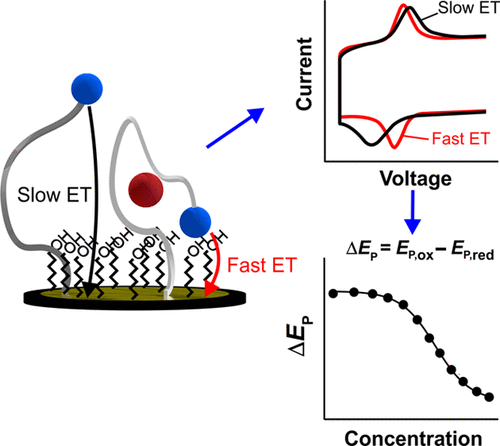Our official English website, www.x-mol.net, welcomes your feedback! (Note: you will need to create a separate account there.)
Interrogation of Electrochemical Aptamer-Based Sensors via Peak-to-Peak Separation in Cyclic Voltammetry Improves the Temporal Stability and Batch-to-Batch Variability in Biological Fluids
ACS Sensors ( IF 8.9 ) Pub Date : 2021-02-18 , DOI: 10.1021/acssensors.0c02455 Miguel Aller Pellitero 1 , Samuel D. Curtis 1 , Netzahualcóyotl Arroyo-Currás 1, 2, 3
ACS Sensors ( IF 8.9 ) Pub Date : 2021-02-18 , DOI: 10.1021/acssensors.0c02455 Miguel Aller Pellitero 1 , Samuel D. Curtis 1 , Netzahualcóyotl Arroyo-Currás 1, 2, 3
Affiliation

|
Electrochemical, aptamer-based (E-AB) sensors support continuous, real-time measurements of specific molecular targets in complex fluids such as undiluted serum. They achieve these measurements by using redox-reporter-modified, electrode-attached aptamers that undergo target binding-induced conformational changes which, in turn, change electron transfer between the reporter and the sensor surface. Traditionally, E-AB sensors are interrogated via pulse voltammetry to monitor binding-induced changes in transfer kinetics. While these pulse techniques are sensitive to changes in electron transfer, they also respond to progressive changes in the sensor surface driven by biofouling or monolayer desorption and, consequently, present a significant drift. Moreover, we have empirically observed that differential voltage pulsing can accelerate monolayer desorption from the sensor surface, presumably via field-induced actuation of aptamers. Here, in contrast, we demonstrate the potential advantages of employing cyclic voltammetry to measure electron-transfer changes directly. In our approach, the target concentration is reported via changes in the peak-to-peak separation, ΔEP, of cyclic voltammograms. Because the magnitude of ΔEP is insensitive to variations in the number of aptamer probes on the electrode, ΔEP-interrogated E-AB sensors are resistant to drift and show decreased batch-to-batch and day-to-day variability in sensor performance. Moreover, ΔEP-based measurements can also be performed in a few hundred milliseconds and are, thus, competitive with other subsecond interrogation strategies such as chronoamperometry but with the added benefit of retaining sensor capacitance information that can report on monolayer stability over time.
中文翻译:

循环伏安法中峰-峰分离对基于电化学适体的传感器的询问提高了生物流体的时间稳定性和批次间的可变性
基于电化学适体(E-AB)的传感器支持对复杂流体(例如未稀释的血清)中特定分子靶标进行连续,实时的测量。他们通过使用氧化还原记者修饰的,带有电极的适体进行靶结合诱导的构象变化,从而改变了报告分子与传感器表面之间的电子传递,从而实现了这些测量。传统上,通过脉冲伏安法对E-AB传感器进行询问,以监视结合诱导的传输动力学变化。尽管这些脉冲技术对电子传输的变化敏感,但它们也响应由生物污垢或单层解吸驱动的传感器表面的逐步变化,因此会出现明显的漂移。而且,我们从经验上观察到,大概是通过场致动适体,差分电压脉冲可以加速单层从传感器表面脱附。相反,在这里,我们证明了使用循环伏安法直接测量电子转移变化的潜在优势。在我们的方法中,目标浓度是通过峰-峰间距Δ的变化来报告的E P,循环伏安图。由于ΔE P的大小对电极上的适体探针数量的变化不敏感,因此,经ΔE P询问的E-AB传感器具有抗漂移能力,并显示出批次之间和批次之间的日常变化性降低。传感器性能。此外,基于ΔE P的测量还可以在几百毫秒内执行,因此,与其他亚秒级询问策略(例如计时电流分析法)相比,具有竞争优势,但具有保留传感器电容信息(可随时间报告单层稳定性)的额外好处。
更新日期:2021-03-26
中文翻译:

循环伏安法中峰-峰分离对基于电化学适体的传感器的询问提高了生物流体的时间稳定性和批次间的可变性
基于电化学适体(E-AB)的传感器支持对复杂流体(例如未稀释的血清)中特定分子靶标进行连续,实时的测量。他们通过使用氧化还原记者修饰的,带有电极的适体进行靶结合诱导的构象变化,从而改变了报告分子与传感器表面之间的电子传递,从而实现了这些测量。传统上,通过脉冲伏安法对E-AB传感器进行询问,以监视结合诱导的传输动力学变化。尽管这些脉冲技术对电子传输的变化敏感,但它们也响应由生物污垢或单层解吸驱动的传感器表面的逐步变化,因此会出现明显的漂移。而且,我们从经验上观察到,大概是通过场致动适体,差分电压脉冲可以加速单层从传感器表面脱附。相反,在这里,我们证明了使用循环伏安法直接测量电子转移变化的潜在优势。在我们的方法中,目标浓度是通过峰-峰间距Δ的变化来报告的E P,循环伏安图。由于ΔE P的大小对电极上的适体探针数量的变化不敏感,因此,经ΔE P询问的E-AB传感器具有抗漂移能力,并显示出批次之间和批次之间的日常变化性降低。传感器性能。此外,基于ΔE P的测量还可以在几百毫秒内执行,因此,与其他亚秒级询问策略(例如计时电流分析法)相比,具有竞争优势,但具有保留传感器电容信息(可随时间报告单层稳定性)的额外好处。


























 京公网安备 11010802027423号
京公网安备 11010802027423号